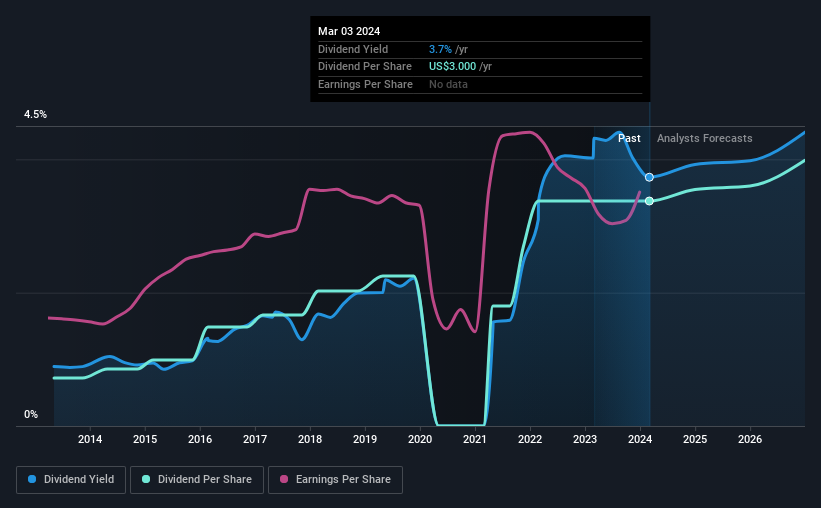Here's What We Like About Carter's' (NYSE:CRI) Upcoming Dividend
Carter's, Inc. (NYSE:CRI) is about to trade ex-dividend in the next four days. The ex-dividend date is usually set to be one business day before the record date which is the cut-off date on which you must be present on the company's books as a shareholder in order to receive the dividend. The ex-dividend date is of consequence because whenever a stock is bought or sold, the trade takes at least two business day to settle. This means that investors who purchase Carter's' shares on or after the 8th of March will not receive the dividend, which will be paid on the 29th of March.
The company's next dividend payment will be US$0.80 per share. Last year, in total, the company distributed US$3.00 to shareholders. Looking at the last 12 months of distributions, Carter's has a trailing yield of approximately 3.7% on its current stock price of US$80.40. Dividends are a major contributor to investment returns for long term holders, but only if the dividend continues to be paid. That's why we should always check whether the dividend payments appear sustainable, and if the company is growing.
View our latest analysis for Carter's
Dividends are typically paid out of company income, so if a company pays out more than it earned, its dividend is usually at a higher risk of being cut. Carter's paid out a comfortable 48% of its profit last year. That said, even highly profitable companies sometimes might not generate enough cash to pay the dividend, which is why we should always check if the dividend is covered by cash flow. Luckily it paid out just 24% of its free cash flow last year.
It's positive to see that Carter's's dividend is covered by both profits and cash flow, since this is generally a sign that the dividend is sustainable, and a lower payout ratio usually suggests a greater margin of safety before the dividend gets cut.
Click here to see the company's payout ratio, plus analyst estimates of its future dividends.
Have Earnings And Dividends Been Growing?
Companies that aren't growing their earnings can still be valuable, but it is even more important to assess the sustainability of the dividend if it looks like the company will struggle to grow. If earnings fall far enough, the company could be forced to cut its dividend. With that in mind, we're not enthused to see that Carter's's earnings per share have remained effectively flat over the past five years. We'd take that over an earnings decline any day, but in the long run, the best dividend stocks all grow their earnings per share. Earnings per share growth in recent times has not been a standout. However, companies that see their growth slow can often choose to pay out a greater percentage of earnings to shareholders, which could see the dividend continue to rise.
Another key way to measure a company's dividend prospects is by measuring its historical rate of dividend growth. Carter's has delivered 17% dividend growth per year on average over the past 10 years.
Final Takeaway
Should investors buy Carter's for the upcoming dividend? The company has barely grown earnings per share over this time, but at least it's paying out a decently low percentage of its earnings and cashflow as dividends. This could suggest management is reinvesting in future growth opportunities. We would prefer to see earnings growing faster, but the best dividend stocks over the long term typically combine strong earnings per share growth with a low payout ratio, and Carter's is halfway there. It's a promising combination that should mark this company worthy of closer attention.
While it's tempting to invest in Carter's for the dividends alone, you should always be mindful of the risks involved. Case in point: We've spotted 2 warning signs for Carter's you should be aware of.
Generally, we wouldn't recommend just buying the first dividend stock you see. Here's a curated list of interesting stocks that are strong dividend payers.
Have feedback on this article? Concerned about the content? Get in touch with us directly. Alternatively, email editorial-team (at) simplywallst.com.
This article by Simply Wall St is general in nature. We provide commentary based on historical data and analyst forecasts only using an unbiased methodology and our articles are not intended to be financial advice. It does not constitute a recommendation to buy or sell any stock, and does not take account of your objectives, or your financial situation. We aim to bring you long-term focused analysis driven by fundamental data. Note that our analysis may not factor in the latest price-sensitive company announcements or qualitative material. Simply Wall St has no position in any stocks mentioned.

